
Next this position is assumed by holding the left hand with the
right hand on top and following prayers are recited:
How to Pray ESHA, (Four rakats)
In order to perform a Four rakats Prayer, you have to perform step 1 - 29
(In
GREEN the Arabic words are given
which
have to recite in salat)
Step 1
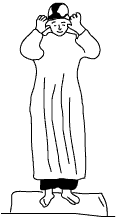
This
posture is called qiyam and it is assumed after having made
the
intention to pray. Raising both hands up to the ears (palms
facing
the Qiblah) "Allah u Akbar" ("Allah
is the greatest") is said.
Step 2

Next
this position is assumed by holding the left hand with the
right
hand on top and following prayers are recited:
1.Thana (or Sana)
"Subhanaka Allah humma wa bihamdika, wa
tabaraka
ismuka,
wa
ta'ala jadduka, wa la ilaha ghairuk"
"Praise
and glory be to you O Allah. Blessed be Your Name,
exalted
be Your Majesty and Glory. There is no God but You"
2.Ta'awadh
"Audu bi Allah i mina ashaitan i errajeem"
"I seek Allah's shelter from Satan, the condemned"
3.Tasmiah
"Bismillah i rrahman i erraheem"
"In
the Name of Allah, the Beneficent, the Merciful."
4.Al-Fatihah,
and any short surah or a few verses from the
Holy
Quran.
"Al humdo lil-lahi rab-bil al ala-meen. Arrahman i rraheem.
Maliki
yaum i eddeen. Iyyaka nabudu wa iyyaka nasta een.
Ihdinas
sirata almustaqeem. Siratal lazhina anamta alaihim,
ghairil
maghdubi alaihim, wa la adhdhaal leen. (Aameen)"
"Praise
be to Allah, The Cherisher and Sustainer of the
Worlds;
Most Gracious, Most Merciful; Master of the Day of
Judgment.
Thee do we worship, and Thine aid we seek.
Show
us the straight way, the way of those on whom Thou
hast
bestowed Thy Grace, Those whose (portion) is not
wrath,
And who go not astray."
5.A
short Sura or a few verses from the Holy Quran - examples
are
given in the last chapter of this guide.
Step 3
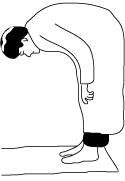
Saying
"Allah u Akbar"(the back & leg
should be perpendicular to
each
other) this position is assumed as shown in the figure. This
position
is called ruku and the prayers as given are recited (three
times).
"Subhana rabbiya al azeem"
"Glorified
is my Lord, the Great"
Step
4
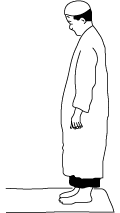 While
going back to qiyam position the first prayer, as given below,
While
going back to qiyam position the first prayer, as given below,
is
said. Then having taken this position the second prayer is said:
"Samia Allah u liman hamidah"
"Allah listens to him who praises Him"
"Rabbana wa laka al hamd"
"Our
Lord, praise be for you only"
Step 5
 This
position is called sujood. Saying "Allah u
Akbar"
("Allah is the
This
position is called sujood. Saying "Allah u
Akbar"
("Allah is the
greatest")
one prostrates as shown and then the prayer below is
said
(three times).
"Subhana rubbiyal a'ala"
"Glory
to Allah, the Exalted".
Step 6
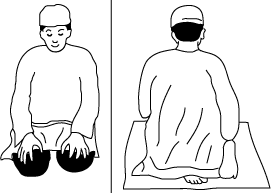 Saying
"Allah u Akbar" ("Allah is the
Saying
"Allah u Akbar" ("Allah is the
greatest")
and rising from the Sujood
position,
this posture called Juloos is assumed
and
the prayer below is said:
"'Rabbi eghfir lee wa rhamnee"
"O
my Lord, forgive me and have Mercy on
me"
Step
7
 Saying
"Allah u Akbar" ("Allah is the
greatest")
the sujood position
Saying
"Allah u Akbar" ("Allah is the
greatest")
the sujood position
is
re-assumed and the prayer below is recited (three times).
"Subhana rubbiyal a'ala"
"Glory
to Allah, the Exalted"
Step 8

Saying
"Allah u Akbar" ("Allah is the
greatest")
this position of
qiyam
is assumed once again to begin the second rakat, and the
following
prayers are recited:
Al-Fatihah, and Any short surah or some verses of the Holy
Quran.
Step 9

Saying
"Allah u Akbar", this position is
assumed
as shown in the
figure.
This position is called ruku and the prayers as given are
recited
(three times).
"Subhana rabbiya al azeem"
"Glorified is my Lord, the Great"
Step 10

While
going back to qiyam position the first prayer, as given below,
is
said. Then having taken this position prayer the second is said:
"Samia Allah u liman hamidah"
"Allah listens to him who praises Him"
"Rabbana wa laka al hamd"
"Our
Lord, praise be for you only"
Step 11
 This
position is called sujood. Saying "Allah u
Akbar"
("Allah is the
This
position is called sujood. Saying "Allah u
Akbar"
("Allah is the
greatest")
one prostrates as shown and then the prayer below is
said
(three times).
"Subhana rubbiyal a'ala"
"Glorified
is my Lord, the Exalted"
Step 12

Saying
"Allah u Akbar" ("Allah is the
greatest")
and rising from the sujood position,
this
posture is assumed and the prayer below
is
said:
"Rabbi eghfir lee wa rhamnee"
"O
my Lord, forgive me and have Mercy on
me"
Step 13
 Saying
"Allah u Akbar" ("Allah is the
greatest")
the sujood position
Saying
"Allah u Akbar" ("Allah is the
greatest")
the sujood position
is
re-assumed and the prayer below is said (three times).
"Subhana rubbiyal a'ala"
"Glory
to Allah, the Exalted"
Step 14

In
this posture these prayers are to be
recited:
1."Tashahud
"Attahiyat u lil Allah i wa assalawat u
wa
attaiyibat. Assalam u a'laika aiyoha
annabiyyu
wa rahmat u Allah i wa
barakatuh.
Assalam u a'laina wa a'la
ebadi
e llahi essaliheen.
(move
your first finger up and down as
shown
while reciting the last part of
Tashahud)

Ashehadu alla ilaha illa Allah u wa
ashhadu
anna Muhammadan abduhu wa
rasooluh.
"All
our oral, physical and monetary
ways
of worship are only for Allah.
Peace,
mercy and blessing of Allah be
on
you, O Prophet. May peace be upon
us
and on the devout slaves of Allah. I
testify
that there is no God but Allah
and
I testify that Muhammad is His
slave
and messenger".
Step 15
 Saying
"Allah u Akbar" ("Allah is the
greatest")
this position of
Saying
"Allah u Akbar" ("Allah is the
greatest")
this position of
qiyam
is assumed once again to begin the second rakat, and the
following
prayers are recited:
Al-Fatihah only .(NO QURANIC SURAH AFTER
SURAH FATHIA)
Step 16
 Saying
"Allah u Akbar", this position is
assumed
as shown in the
Saying
"Allah u Akbar", this position is
assumed
as shown in the
figure.
This position is called ruku and the prayers as given are
recited
(three times).
"Subhana rabbiya al azeem"
"Glorified
is my Lord, the Great"
Step 17
 While
going back to qiyam position the first prayer, as given below,
While
going back to qiyam position the first prayer, as given below,
is
said. Then having taken this position prayer the second is said:
"Samia Allah u liman hamidah"
"Allah listens to him who praises Him"
"Rabbana wa laka al hamd"
"Our
Lord, praise be for you only"
Step 18
 This
position is called sujood. Saying "Allah u
Akbar"
("Allah
is the
This
position is called sujood. Saying "Allah u
Akbar"
("Allah
is the
greatest")
one prostrates as shown and then the prayer below is
said
(three times).
"Subhana rubbiyal a'ala"
"Glorified
is my Lord, the Exalted"
Step 19
 Saying "Allah u Akbar" ("Allah is
the
Saying "Allah u Akbar" ("Allah is
the
greatest")
and rising from the sujood position,
this
posture is assumed and the prayer below
is
said:
"Rabbi eghfir lee wa rhamnee"
"O
my Lord, forgive me and have Mercy on
me"
Step 20
 Saying
"Allah u Akbar" ("Allah is the
greatest")
the sujood position
Saying
"Allah u Akbar" ("Allah is the
greatest")
the sujood position
is
re-assumed and the prayer below is said (three times).
"Subhana rubbiyal a'ala"
"Glory
to Allah, the Exalted"
Step 21
 Saying
"Allah u Akbar" ("Allah is the
greatest")
this position of
Saying
"Allah u Akbar" ("Allah is the
greatest")
this position of
qiyam
is assumed once again to begin the second rakat, and the
following
prayers are recited:
Al-Fatihah only ( NO QURANI SURAH AFTER SURAH FATHIA)
Step 22
 Saying
"Allah u Akbar", this position is
assumed
as shown in the
Saying
"Allah u Akbar", this position is
assumed
as shown in the
figure.
This position is called ruku and the prayers as given are
recited
(three times).
"Subhana rabbiya al azeem"
"Glorified
is my Lord, the Great"
Step 23
 While
going back to qiyam position the first prayer, as given below,
While
going back to qiyam position the first prayer, as given below,
is
said. Then having taken this position prayer the second is said:
"Samia Allah u liman hamidah"
"Allah listens to him who praises Him"
"Rabbana wa laka al hamd"
"Our
Lord, praise be for you only"
Step 24

This
position is called sujood. Saying "Allah u
Akbar"
("Allah is the
greatest")
one prostrates as shown and then the prayer below is
said
(three times).
"Subhana rubbiyal a'ala"
"Glorified
is my Lord, the Exalted"
Step 25

Saying
"Allah u Akbar" ("Allah is the
greatest")
and rising from the sujood position,
this
posture is assumed and the prayer below
is
said:
"Rabbi eghfir lee wa rhamnee"
"O
my Lord, forgive me and have Mercy on
me"
Step 26
 Saying
"Allah u Akbar" ("Allah is the
greatest")
the sujood position
Saying
"Allah u Akbar" ("Allah is the
greatest")
the sujood position
is
re-assumed and the prayer below is said (three times).
"Subhana rubbiyal a'ala"
"Glory
to Allah, the Exalted"
Step 27

In this posture these prayers are to be
recited:
1."Tashahud
"Attahiyat u lil Allah i wa assalawat u
wa
attaiyibat. Assalam u a'laika aiyoha
annabiyyu
wa rahmat u Allah i wa
barakatuh.
Assalam u a'laina wa a'la
ebadi
e llahi essaliheen.
(move
your first finger up and down as
shown
while reciting the last part of
Tashahud)

Ashehadu alla ilaha illa Allah u wa
ashhadu
anna Muhammadan abduhu wa
rasooluh.
"All
our oral, physical and monetary
ways
of worship are only for Allah.
Peace,
mercy and blessing of Allah be
on
you, O Prophet. May peace be upon
us
and on the devout slaves of Allah. I
testify
that there is no God but Allah
and
I testify that Muhammad is His
slave
and messenger".
2."Salat
Ala An-nabi"
"Allah umma salli a'la Muhammadin wa
ala
aali Muhummadin, kama sallaita ala
Ibraheema,
wa ala aali Ibraheem,
innaka
hameedun majeed. Allah u mma
barik
a'la Muhammadin wa ala aali
Muhummadin,
kama barakta ala
Ibraheema,
wa ala aali Ibraheem,
innaka
h ameedun majeed".
"O
God send your Mercy on Muhammad
and
his posterity as you sent Your
mercy
on Abraham and his posterity.
You
are the Most Praised, The Most
Glorious.
O God, send your Blessings on
Muhammad
and his posterity as you
have
blessed Abraham and his
posterity.
You are the Most praised,
The
Most Glorious".
3.A short prayer
"Rubbana aatina fi uddunya hasanatun
wa
fi l aakherati hasah, waqina
a'zabannar".
"Our
Lord, grant us the good of this
world
and that of the Hereafter and
save
us from the torture of Hell."
Step 28
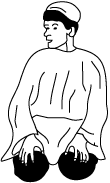 Having
said the above mentioned prayers, turning the face to the
Having
said the above mentioned prayers, turning the face to the
right.
This following prayer is read:
"Assalam u a'laikum wa rahmatu Allah".
"Peace and mercy of Allah be on you".
Note:
This Salam (Prayer for Peace) is directed to the angels and the
muslims
to our right and to the left
Step 29
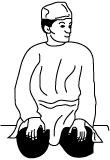 Then
turning the face to the left, the prayer above is said again:
Then
turning the face to the left, the prayer above is said again:
"Assalam u a'laikum wa rahmatu Allah".
"Peace
and mercy of Allah be on you".
SALAT-UL- ESHA ENDS
*
IMPORTANT POINT TO NOTE FOR
ESHA
* Holy quran is recited loudly in
qiyyam(standing
position) in first 2 rakat
* The followers will have not to recite
anything
in all 4 rakarts in standing
posture except
thanna(sana)
in first rakat.
* If some one is offering prayer of
esha
alone,he/she will have to recite
thanna,sura fathia and any
qurani
sura slowly/little voice
* In first two rakat quranic surah is
recited
followed by surah fathia but
in the rest of the last
two
rakats no quranic surah is recited after
surah-e-fathia.
COMPOSITION OF ESHA ( Total 17 rakats)
4.rakat sunnah
(optional---may be left)
4.rakat farz (compulsory)
2.rakat sunnah
2 rakat nafil
3.rakat of vitar ( it is described seperately)
2
nafil (optional)
TIMING OF ESHA
when the darkness covers whole the
atmospher.
stars becomes visible
on the sky and its' times remain till
fajir,next
morning prayer.But try
to offer in early time.
knowing
exact timing of salat in your country /city